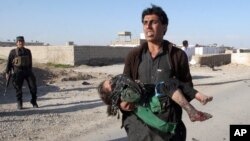The United Nations says conflict-related incidents in Afghanistan killed more than 280 children in the first four months of this year, a 21 percent increase compared to the same period in 2016.
The U.N. Assistance Mission in Afghanistan, or UNAMA, released the figures Monday, noting the number of child fatalities is the highest for the same comparable period since it began documenting civilian casualties in 2009.
"Between 1 January and 30 April 2017, UNAMA preliminarily recorded 987 child casualties [283 deaths and 704 injured]," the mission said.
While ground fighting was blamed for 42 percent of the child deaths, the rest were caused by explosive remnants of war, aerial operations by pro-government forces and improvised explosive devices, or IEDs, planted by insurgents.
UNAMA said it was deeply concerned by the continued increase in child deaths this year and called on parties to the conflict to take urgent steps to reduce harm.
The latest incident of Afghan child casualties took place Sunday when an unexploded mortar round killed five boys from the same family in the eastern Laghman province. The victims ranged in age from six to 12 years old, according to local officials.
"A family destroyed in seconds. This horror is just one of too many incidents documented at the onset of this fighting season," UNAMA quoted its chief, Tadamichi Yamamoto, as saying.
It noted that child deaths have risen during 2017, largely as a result of persistent use of indirect and/or explosive weapons in civilian-populated areas and due to the use of illegal and indiscriminate improvised explosive devices.
"Many of the more than 700 children injured in conflict-related incidents have suffered life-changing injuries, including loss of limbs, as well as significant and lasting trauma such as witnessing the death of siblings, parents, destruction to their homes or displacement," according to UNAMA.
Civilian casualties, however, are expected to increase this year because of a widely anticipated escalation in Afghan hostilities.
The Taliban has vowed to expand the conflict to all Afghan provinces, and U.S. President Donald Trump's administration is considering sending several thousand additional troops to help Afghan forces reverse insurgent gains.









